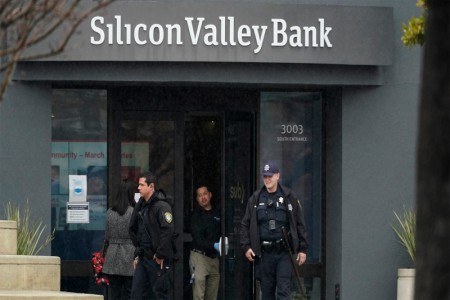In the rush for answers, some politicians, regulators and bank executives have found an easy scapegoat in The Federal Reserve, an institution tasked with supervising banks to ensure they operate in a safe and sound manner.
In reality, the answer is likely more nuanced than that. Many moving parts were at play. Below are just a few.
Blame the Fed: SVB's downfall was largely caused by a record $42 billion bank run which left the bank in desperate need of cash. But the Fed's rate hikes had undermined the value of bonds, a critical source of capital for SVB. The bank was forced to sell them quickly at a substantial loss, leading to a liquidity crisis.
But the writing was on the wall for SVB long before the crisis occurred, said Aaron Klein, a senior fellow at the Brookings Institution. who worked on financial regulation under the Obama administration.
The bank's assets nearly quadrupled over the course of four years and it took out vast sums of mortgage-backed securities without hedging for potential interest rate hikes, he Klein wrote in an opinion piece in an opinion piece for MarketWatch. There were more warnings signs, he said: About 90% of the bank's deposits were uninsured and SVB had become the largest borrower from the Federal Home Loan Bank (FHLB) in San Francisco. The FHLB has been called a "lender of next-to-last resort" by Fed staff.
These were all red flags that the Fed should have known about, said Klein. "The Federal Reserve failed as a bank supervisor," he wrote.
On Capitol Hill, frequent Fed critic Sen. Elizabeth Warren has been quick to blame Federal Reserve Chair Jerome Powell for a lack of oversight.
"Powell's actions to allow big banks like Silicon Valley Bank to boost their profits by loading up on risk directly contributed to these bank failures," she said in a statement Tuesday.
Banking advocates agree. "The failure of SVB appears to reflect primarily a failure of management and supervision rather than regulation," wrote the Bank Policy Institute, an industry group, in a report on Tuesday.
Blame Congress: But the distinction between supervision and regulation is an important one: The central bank typically operates within a framework set by Congress.
In 2018, Congress instituted reforms to the Dodd-Frank consumer protection act, which rolled back rules subjecting banks to the Fed's rigorous stress tests.
Under the new plan, banks with less than $250 billion in assets, like SVB, were no longer subject to an annual health check.
SVB's former chief executive officer, Greg Becker, had urged Congress to raise the threshold from its previous $50 billion.
Becker said at the time that imposing the regulations when a bank hit the $50 billion level would "unnecessarily" burden SVB, which then had assets approaching $40 billion, and require the company to spend time and money complying with rules instead of providing loans to job creators.
That created a tough situation for the Fed, Columbia Business School professor Kairong Xiao told CNN.
"It's unfair to blame the Federal Reserve because they do what lawmakers tell them to do," Xiao said. "They don't have the regulatory power, but they kind of have to clean up the mess afterwards."
Still, the rollback law did give the Fed the right to choose to apply the regulations to particular banks with at least $100 billion in assets. At the end of 2022, SVB had $209 billion in assets.
Blame SVB: Others say the blame should be placed on the banks themselves.
There is no way SVB executives didn't foresee the crash in bond value, University of Chicago Harris School of Public Policy professor Dave Schabes told CNN.
"Powell has been very clear he's going to fight inflation, and he's warned the markets again and again, about thinking things are over," he said. "You'd have to kind of be half asleep to not have heard that message."
It comes down to banks making high-risk bets with customers' money, said Joe Brusuelas, chief economist for RSM.
"For too many private sector actors it's always going to be easier to point the finger at the Fed rather than taking a good long, hard look in the mirror," he told CNN. "Too many opt for short term gains at the expense of long term stability despite the clear risks associated with a borrow short, lend long strategy."
Blame the San Francisco Fed: Still, that doesn't mean the Federal Reserve Bank of San Francisco, which led supervision of SVB, is off the hook.
The relaxed balance sheet management and high-risk investments at SVB shouldn't have been allowed and "it's the job of regulators to call that out," said Brusuelas. "That is why we have regulators and why banks need to be the subject of rigorous oversight."
The San Francisco Fed — whose board included Becker, up until last week —, "would have enough inside information [about SVB]" to know what was happening internally, said Schabes. "But I think that people who want to blame the regulators missed the point. These well-paid bank executives should be knowledgeable about their business, and the first responsibility lies there," he added.
What comes next: The Fed sprang into action on Sunday and quickly created the Bank Term Lending Program, a $25 billion stopgap meant to provide "an additional source of liquidity against high-quality securities, eliminating an institution's need to quickly sell securities in times of stress."
On Monday, Powell announced that the Fed would launch a review of how it handled oversight of SVB. The Wall Street Journal also reported that the central bank is strongly considering instituting a set of tougher rules for mid-sized banks.


